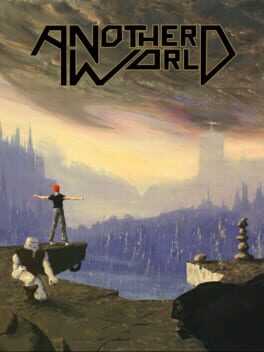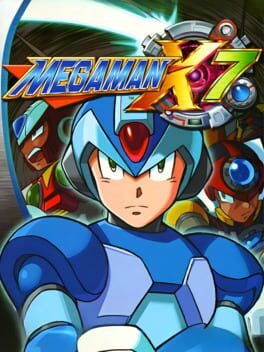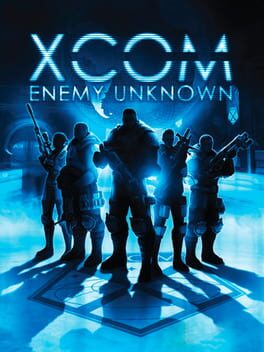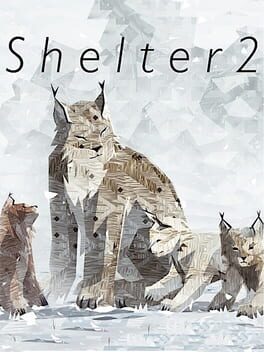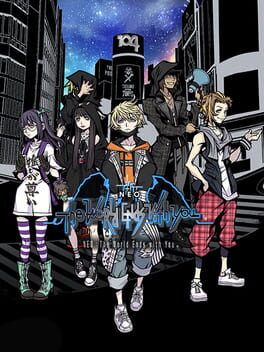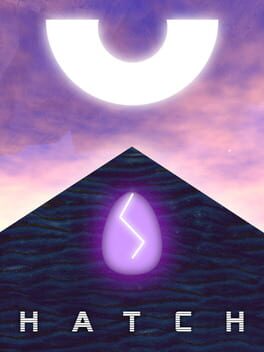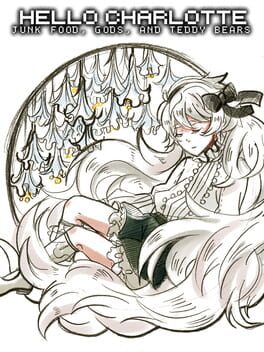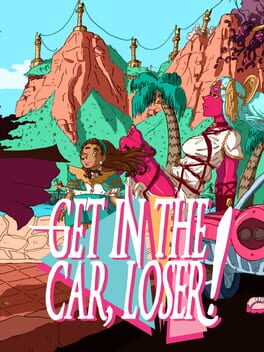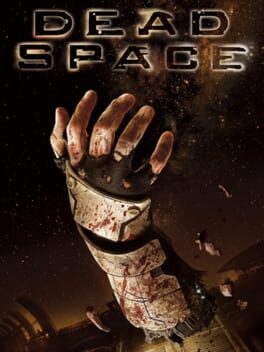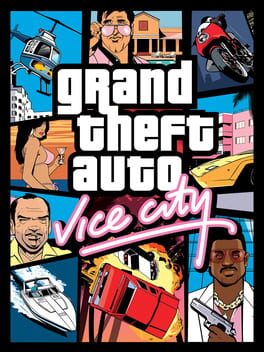rubenmg
Somehow similar to GTA III in how it takes its open world condition. The first impression may differ from this view, the New York life one tried to communicate with tons of NPCs on screen doing nothing in particular contrasts with the desertic Mars where everyone seems to be either a worker or a cop. However, upon tackling the action it’s another story.
Except for a few more gimmicky missions, that are the lowest points, Red Faction Guerrilla unifies in harmony its objectives and its chaotic systems. To kill a sniper you can search for their exact location or you can just demolish the whole building they are in. What makes the game fun all throughout is that the messy behavior of each system piles up to give interesting situations constantly. You can enter a fortress by searching for the entrance or you can just hammer your way in. Better yet, pick up a good vehicle, build speed and crash through any wall. Similarly, the way the enemy and ally reinforcements join the multiple battles keep giving a persistent sense of life that adds to the destructive nature of the game as war wages while everything gets demolished in the way.
There are just some impressive, probably even unwanted, details due to being consistent with the open world and its physical presence. From the slapstick comedic tragedy of seeing the building you just took the pillars off crumbling you into death, as many years of Minecraft made us forget about gravity, to keep seeing how alerts for enemy buildings being destroyed pop up while on a mission and realizing that, at least just for a bit, somewhere out of there the world is still alive and reacting even if you’re not watching.
Except for a few more gimmicky missions, that are the lowest points, Red Faction Guerrilla unifies in harmony its objectives and its chaotic systems. To kill a sniper you can search for their exact location or you can just demolish the whole building they are in. What makes the game fun all throughout is that the messy behavior of each system piles up to give interesting situations constantly. You can enter a fortress by searching for the entrance or you can just hammer your way in. Better yet, pick up a good vehicle, build speed and crash through any wall. Similarly, the way the enemy and ally reinforcements join the multiple battles keep giving a persistent sense of life that adds to the destructive nature of the game as war wages while everything gets demolished in the way.
There are just some impressive, probably even unwanted, details due to being consistent with the open world and its physical presence. From the slapstick comedic tragedy of seeing the building you just took the pillars off crumbling you into death, as many years of Minecraft made us forget about gravity, to keep seeing how alerts for enemy buildings being destroyed pop up while on a mission and realizing that, at least just for a bit, somewhere out of there the world is still alive and reacting even if you’re not watching.
1991
The first steps in Prince of Persia are a bit rough not because of the environment, which presents almost no obstacles and a lot of room to discover by accident instead, but because this new body contrasts with the usual lightweight platformers. Now each step counts, building speed is crucial and a calculated process. Even when familiarized with the controls and the levels the weight is still there in every single movement.
One of the first hits to succeed Prince of Persia was Another World. At first glance, the influence is obvious, the rotoscope animations, the silent minimalistic 2d environment with a "realistic" body to move… However, at the very first screen it becomes clear that it didn't get what made Prince of Persia really unique. The sections that asked to explore and carefully calculate your motions are now contained mini scenes to be repeated until solving the conflict. This usually leads to a result of scratching your head trying to understand what exact thing the game is asking of you or repeating a platformer/action section with the most lifeless movement ever created until you learn all the traps. In both cases, dragging the pace. Yes, there were some more logic driven moments in Prince of Persia and the surprise of the traps made little sense considering the repetition too, but they were anecdotic towards the real action. Here all the weight is watered down in favor of a constant search for the exact solution.
In some universe, the weight of our bodies would still be as popular as the speedrun feeling of keeping an inhuman movement forward constant. At least, fortunately, the concept has never been totally forgotten. Unfortunately, Another World proposed that platforming and action were about being cinematic, which apparently meant solving sequential bad puzzles.
One of the first hits to succeed Prince of Persia was Another World. At first glance, the influence is obvious, the rotoscope animations, the silent minimalistic 2d environment with a "realistic" body to move… However, at the very first screen it becomes clear that it didn't get what made Prince of Persia really unique. The sections that asked to explore and carefully calculate your motions are now contained mini scenes to be repeated until solving the conflict. This usually leads to a result of scratching your head trying to understand what exact thing the game is asking of you or repeating a platformer/action section with the most lifeless movement ever created until you learn all the traps. In both cases, dragging the pace. Yes, there were some more logic driven moments in Prince of Persia and the surprise of the traps made little sense considering the repetition too, but they were anecdotic towards the real action. Here all the weight is watered down in favor of a constant search for the exact solution.
In some universe, the weight of our bodies would still be as popular as the speedrun feeling of keeping an inhuman movement forward constant. At least, fortunately, the concept has never been totally forgotten. Unfortunately, Another World proposed that platforming and action were about being cinematic, which apparently meant solving sequential bad puzzles.
2003
The game is very evidently half baked, with a sense of bugginess in every motion and, to top it off, the more gimmicky ideas seem to tell that there wasn’t even a solid concept to work upon. Add a weak intro level and a tiresome story told through unskippable cutscenes that appear again and again, the mixing for failure is done. Perhaps because it is so messy, or out of curiosity of why this one in all the franchise was so poorly received, it is also a Mega Man game that kept me interested up to the very end, which is an achievement.
Sometimes intentionally, some others not, the title ends up building pretty tight fights quite often. On the most probably thought part, the initial two protagonists are a simple yet successful complement to each other, the agility but risky close range offensive of Zero and the safety on the distance but poor tools when cornered of Axl. The levels themselves tend to be quite bad, the best thing I can say about them is that they can be speedrun skipped without issues, which usually is the best way to tackle them. Saying that something is easily avoidable is secretly one of the ugliest insults, but at least it lends space into a boss rush approach.
The 3D is interestingly used in these fights, always slightly touching the camera angle or the arena navigation to modify in turn the perception and dynamics of the action. Again, the bosses are dumb, but in their dumb behaviour there is something that clicks more than it should. There is the fire guy who will circle around while shooting with 2 clones of him, occasionally cross attack through you, at the center of the ambush you’ll also have to deal with a missile launching platform and, to finish off, you are fighting on top of a mech, so it won’t be rare to get some weird momentum mixed in. What is a very simple behavior unexpectedly keeps you moving and reacting in a pace that some action games could only dream of. Boss fights keep maintaining this tension constantly just using simple patterns that build on top of each other and rarely leave room for breath. There’s the water boss who not only doesn’t leave any clear window open to get free hits, the classically boring design where offense and defense are separate things contaminating even the most technically complex hack and slash of your preference, but will keep switching patterns all the time. For some, this is poor design. In my dictionary, this is what you call a proper fight.
A disaster? Kind of. But one that at least tries things and can be unironically enjoyed, much more than the rest of the NFT like produced entries in the series.
Sometimes intentionally, some others not, the title ends up building pretty tight fights quite often. On the most probably thought part, the initial two protagonists are a simple yet successful complement to each other, the agility but risky close range offensive of Zero and the safety on the distance but poor tools when cornered of Axl. The levels themselves tend to be quite bad, the best thing I can say about them is that they can be speedrun skipped without issues, which usually is the best way to tackle them. Saying that something is easily avoidable is secretly one of the ugliest insults, but at least it lends space into a boss rush approach.
The 3D is interestingly used in these fights, always slightly touching the camera angle or the arena navigation to modify in turn the perception and dynamics of the action. Again, the bosses are dumb, but in their dumb behaviour there is something that clicks more than it should. There is the fire guy who will circle around while shooting with 2 clones of him, occasionally cross attack through you, at the center of the ambush you’ll also have to deal with a missile launching platform and, to finish off, you are fighting on top of a mech, so it won’t be rare to get some weird momentum mixed in. What is a very simple behavior unexpectedly keeps you moving and reacting in a pace that some action games could only dream of. Boss fights keep maintaining this tension constantly just using simple patterns that build on top of each other and rarely leave room for breath. There’s the water boss who not only doesn’t leave any clear window open to get free hits, the classically boring design where offense and defense are separate things contaminating even the most technically complex hack and slash of your preference, but will keep switching patterns all the time. For some, this is poor design. In my dictionary, this is what you call a proper fight.
A disaster? Kind of. But one that at least tries things and can be unironically enjoyed, much more than the rest of the NFT like produced entries in the series.
2008
It is a shame that every system is a little bit bad at best since turning football into a tactical JRPG can be very interesting. As uninspired as the game may be in that regard, the ideas and the heart are still present elsewhere.
Thanks to the game having no restrictions on where it can go, and being at least partially conscious about how stupid the ideas can be, what keeps you wanting more episode after episode is knowing that anything goes and that it will usually have some good heart in it. It may sound surrealist to say that people here get to be friends just because they share an honest passion in football, but in reality it isn’t something that far away from how it was when we were kids (or teenagers (or adults if we were more honest)). What I like the most is that the story practically ignores any logic because it knows it has enough heart. Anyone is welcome on the team as long as Mark feels that they really want to play football in a sincere way.
One of my favorite moments is when Mark and his friends look for the players that his grandfather trained years ago in a search for guidance. Of course, some of them have moved on, their story didn’t end up well and they fear that the new generation will meet the same doomed fate. However, when Mark's attitude transports them to a time where someone put effort into making them comfortable in something as simple as playing football in a team they cannot back down. I guess that when I played this years ago I still was at the age to side more the team feelings, but now I’m closer to the retired players view. Maybe we didn’t have the best outcome in our time, but how can we deny the future if the spirit lives on?
Thanks to the game having no restrictions on where it can go, and being at least partially conscious about how stupid the ideas can be, what keeps you wanting more episode after episode is knowing that anything goes and that it will usually have some good heart in it. It may sound surrealist to say that people here get to be friends just because they share an honest passion in football, but in reality it isn’t something that far away from how it was when we were kids (or teenagers (or adults if we were more honest)). What I like the most is that the story practically ignores any logic because it knows it has enough heart. Anyone is welcome on the team as long as Mark feels that they really want to play football in a sincere way.
One of my favorite moments is when Mark and his friends look for the players that his grandfather trained years ago in a search for guidance. Of course, some of them have moved on, their story didn’t end up well and they fear that the new generation will meet the same doomed fate. However, when Mark's attitude transports them to a time where someone put effort into making them comfortable in something as simple as playing football in a team they cannot back down. I guess that when I played this years ago I still was at the age to side more the team feelings, but now I’m closer to the retired players view. Maybe we didn’t have the best outcome in our time, but how can we deny the future if the spirit lives on?
2001
When focused on more traditional closed shooter sections Halo is an almost alright game. The (few) enemy variety does not make that much difference since Master Chief Rambo is always rapidly firing those giant auto targeted aliens anyway. Likewise, the so praised AI, that I do not doubt that is very worked on, rarely ever shines due to how fast the pacing is, so one questions the importance of this “revolution” when the actual behavior of the enemies is way less charming than something much simpler like Doom enemies getting to fight between them (I’m assuming and hoping that the IA praise isn’t towards the dumb wheel eater allies). And comparing with Doom, remember the worst levels that consisted of big empty arenas full of enemies? That’s about half of Halo, but even worse somehow.
It’s funny to me that the advancements that this popularized in the genre that I perceive are exactly the things that I still find unconvincing after 20 years of iterations. The regenerative health not only causes what happens in almost any FPS ever of hiding behind a wall for a couple of seconds doing nothing, but in the way decreases the supposed greatness of the enemy intelligence as they are incapable of taking the vanguard on your most obvious state of crisis. Worse than that, it probably helped to popularize adding variety in shooting games by reducing the actual shooting with anything else that happens to be worse. I think what pisses me off the most is that the only thing mildly interesting in the combat, the constant movement due to the open space and enemy designs (even with a pretty standard movement), is completely tossed away by umm… the worst car that you will ever drive, a turret to shoot standing still while eating bullets, and something called a tank that in reality happens to be a giant hitbox amplifier since for some reason any bullet that hits the vehicle damages you directly.
Evolve combat? Sure, but please, not like this.
It’s funny to me that the advancements that this popularized in the genre that I perceive are exactly the things that I still find unconvincing after 20 years of iterations. The regenerative health not only causes what happens in almost any FPS ever of hiding behind a wall for a couple of seconds doing nothing, but in the way decreases the supposed greatness of the enemy intelligence as they are incapable of taking the vanguard on your most obvious state of crisis. Worse than that, it probably helped to popularize adding variety in shooting games by reducing the actual shooting with anything else that happens to be worse. I think what pisses me off the most is that the only thing mildly interesting in the combat, the constant movement due to the open space and enemy designs (even with a pretty standard movement), is completely tossed away by umm… the worst car that you will ever drive, a turret to shoot standing still while eating bullets, and something called a tank that in reality happens to be a giant hitbox amplifier since for some reason any bullet that hits the vehicle damages you directly.
Evolve combat? Sure, but please, not like this.
2012
The weirdest decision in XCOM is having the ironman mode not being optional, but strongly unadvised for the first try. Don’t listen, put it on. It’s not about difficulty, choose easy if you want to, it is about not losing sense. About thinking how rigged are the odds of failing an 80% shot and how right was your call on a lucky 50/50. Really, permanent deaths are not that much of a deal compared to how vital it is to feel that there is only one chance at a moment, to live with your decisions and getting to see when there is no going back, that most of them weren’t neither right nor wrong, just multiple ways of uncertainty.
It also reinforces a defense approach because risks cannot be rewinded until turned into hits. Obviously, the defensive focus sounds bad because usually the defensive stance in games means the worst part, not here though. Don’t venture into the dark, don’t stay uncovered, we are not in this fight to conquer but to defend. It isn’t cowardice to take advantage of the infinite turns, the courage is assumed upon stepping into the battle, it’s about wit. A small step at a time, no turn is bad as long as the final consequence can be explained in that you took care. Let the aliens come, let them retreat, take advantage of whatever they do, split the team to cover all the angles, together in spirit but not clogged with fear.
What’s the worst that can happen? You can’t make it and get the bad ending? As long as you fought with all you had every single time, who can call that as a loss?
It also reinforces a defense approach because risks cannot be rewinded until turned into hits. Obviously, the defensive focus sounds bad because usually the defensive stance in games means the worst part, not here though. Don’t venture into the dark, don’t stay uncovered, we are not in this fight to conquer but to defend. It isn’t cowardice to take advantage of the infinite turns, the courage is assumed upon stepping into the battle, it’s about wit. A small step at a time, no turn is bad as long as the final consequence can be explained in that you took care. Let the aliens come, let them retreat, take advantage of whatever they do, split the team to cover all the angles, together in spirit but not clogged with fear.
What’s the worst that can happen? You can’t make it and get the bad ending? As long as you fought with all you had every single time, who can call that as a loss?
2015
The fundamentals were already defined in the first game. Turning back to check on your children, counting all of them each time. Searching desperately for the food that likes to hide when the hunger is at its high. One of the biggest differences is in the approach, as convincing as some of the set piece driven linear navigation was carried out, the nature calls for the wild, the dread of danger coming from any direction, the prey harder to corner. A harsher world that shows its hazards in just being there, and in consequence, a world where life is more prized.
Despite my bad memory, I still remember much of my first playthrough about 7 years ago. How only one of my cubs survived, often not even knowing how the others got lost. Getting better at my hunts, not sure if because of experience or because all that remained was only one hope. Asking the stars that guided me to a secure den at the start if I misread the constellations, if I did something wrong. As i kept thinking, the little one was no more, it matched my shape and size now, the steps that were always on my back now often stole my lead. I reached the conclusion that it was pointless to ask for what could I have done and better celebrate the life that survived, the life that now had to go away and truly live on its own. I remember being emotional at the ending where the lonely notes didn’t last for long when the stars appeared again and I was reunited somewhere else with, what I thought, was once my child.
Things have changed now. The harsh world that I remembered is bland. Not only you don’t have to go out of your comfort zone at all, completionism being the only incentive to explore to make it worse. Hunting rabbits for the whole year does the job, I don’t even think you need to return to the den at all. Climate changes the look and a bit of what gets added to your collection, but nothing more. The seasons run long, not because of the hard job of keeping the family alive, but because of the tedium of always repeating the same hunt. When the 4 cubs now survived and grew up I didn’t cherish the last moment, I just wanted them to spread as soon as they could, I knew they were ready after all. That ending scene that moved me so much was misunderstood, the 4 lynx survived, but there was only one there waiting for me. Who was that? My own mother, one of my children, some partner that I lost time ago? At least I can still recall the sentiment of what I once thought this was.
Despite my bad memory, I still remember much of my first playthrough about 7 years ago. How only one of my cubs survived, often not even knowing how the others got lost. Getting better at my hunts, not sure if because of experience or because all that remained was only one hope. Asking the stars that guided me to a secure den at the start if I misread the constellations, if I did something wrong. As i kept thinking, the little one was no more, it matched my shape and size now, the steps that were always on my back now often stole my lead. I reached the conclusion that it was pointless to ask for what could I have done and better celebrate the life that survived, the life that now had to go away and truly live on its own. I remember being emotional at the ending where the lonely notes didn’t last for long when the stars appeared again and I was reunited somewhere else with, what I thought, was once my child.
Things have changed now. The harsh world that I remembered is bland. Not only you don’t have to go out of your comfort zone at all, completionism being the only incentive to explore to make it worse. Hunting rabbits for the whole year does the job, I don’t even think you need to return to the den at all. Climate changes the look and a bit of what gets added to your collection, but nothing more. The seasons run long, not because of the hard job of keeping the family alive, but because of the tedium of always repeating the same hunt. When the 4 cubs now survived and grew up I didn’t cherish the last moment, I just wanted them to spread as soon as they could, I knew they were ready after all. That ending scene that moved me so much was misunderstood, the 4 lynx survived, but there was only one there waiting for me. Who was that? My own mother, one of my children, some partner that I lost time ago? At least I can still recall the sentiment of what I once thought this was.
For the first game to be set in a, at the time, current Shibuya was very important in the style and identity of the game both aesthetically and thematically. It was the story of some teenagers seeing the world they lived in with reality juxtaposed within the reaper game, a way to put an outsider's perspective. This was especially important for the main character, Neku, who started the game feeling isolated from that world and then suddenly the first thing he had to do was to read into everyday people’s mind and find a partner in order to survive. Starting from more superficial and direct elements, like the fashion in every district influencing and being influenced by your presence, getting into other thoughts and trying to guide their thinking in the right way… Neku senses opened. Yes, it was still that Shibuya Scramble where you cross with hundreds of unknown faces everyday, but anyhow still a world where Neku is not insignificant, just a part of everything, hence the original title, as cheesy as it may be: It's a Wonderful World. Even though the game stuck with me at the time, replaying it a few years ago was much colder since apart from the premise it didn't really capture me, but at least I could see and appreciate the intention.
NEO is a late sequel, a sequel that maybe never was needed, a sequel asked for just because if you like a game you must ask for more. NEO fails both at trying to capture both the sensations of the modern world and upon reflecting on the place that was left behind in 2007. The most minimum sense of intention is gone, the reaper game is repeated just because that is what it was about, now everything is about an amplified lack of inspiration that before already destroyed the rhythm of a quite catchy premise. There is nothing.
NEO is a late sequel, a sequel that maybe never was needed, a sequel asked for just because if you like a game you must ask for more. NEO fails both at trying to capture both the sensations of the modern world and upon reflecting on the place that was left behind in 2007. The most minimum sense of intention is gone, the reaper game is repeated just because that is what it was about, now everything is about an amplified lack of inspiration that before already destroyed the rhythm of a quite catchy premise. There is nothing.
2019
Upon finishing the game, there is a small reflection where the obstacles you went through are mentioned, implying that this was a somewhat harsh journey, that reaching this place was earned.
It’s quite hard to measure how much a game really wants to push you against the wall, since there will usually be a reasonably obvious way to get through anything (although, it’s very interesting to observe the situations where, for whatever reason, the possibility of completion is gone). Hatch’s resistance falls weak. It’s not only that the way to continue up feels calculated for you to pass through, again, a reasonable conclusion, even if the game didn’t even try to give the illusion of the contrary. Where it falls is in the ignorance of friction and momentum. All the journey is a mere hide and seek of surfaces, when they are hidden, inclined more than 90 degrees.
The only obstacles and their remedies seem to recognize the fundamental problem that is running up any slope always at max speed. The sun like figure is added as a look to avoid in order to not take the easy (geographical) way, making the more open first half feel again constrained, not resistant, looking for the designed angle where you can climb in safety. Falling down, the most evident frustrating experience in climbing, gravity, the ultimate inescapable force, is toned down with a checkpoint system, probably in recognition that repeating the climb, and in consequence the act of climbing, lacked enough substance. “Don’t forget where you came from” says at the end, hard to remember a road where the obstacles are a paved way.
It’s quite hard to measure how much a game really wants to push you against the wall, since there will usually be a reasonably obvious way to get through anything (although, it’s very interesting to observe the situations where, for whatever reason, the possibility of completion is gone). Hatch’s resistance falls weak. It’s not only that the way to continue up feels calculated for you to pass through, again, a reasonable conclusion, even if the game didn’t even try to give the illusion of the contrary. Where it falls is in the ignorance of friction and momentum. All the journey is a mere hide and seek of surfaces, when they are hidden, inclined more than 90 degrees.
The only obstacles and their remedies seem to recognize the fundamental problem that is running up any slope always at max speed. The sun like figure is added as a look to avoid in order to not take the easy (geographical) way, making the more open first half feel again constrained, not resistant, looking for the designed angle where you can climb in safety. Falling down, the most evident frustrating experience in climbing, gravity, the ultimate inescapable force, is toned down with a checkpoint system, probably in recognition that repeating the climb, and in consequence the act of climbing, lacked enough substance. “Don’t forget where you came from” says at the end, hard to remember a road where the obstacles are a paved way.
I’m glad that people connected with Charlotte later on, but I miss something that got lost since this first game. May sound typical for this kind of RPG maker games, but to me the game is entirely about the peculiar and imaginative perception of the world from Charlotte’s view in videogame language.
If I’m allowed to make a guess, I’m pretty sure that most people who grew up with videogames being quite present in their lives have dreamt in videogame terms (specially as children, but also as adults), even daydreaming about them. Something similar must have happened with cinema and TV (camera angles, cuts and such being present in dreams and even when recalling memories) and Hello Charlotte has a lot of this new influence on perception. Her imaginary friend is someone never present that may seem (and may be) a fourth wall breaking reference to the player or just her thinking that she’s a videogame character. The multiple deaths act more as what ifs, what if the world ended if I touch this, what if the scary bear impales me. It may seem insensitive to think about these images, but to me it’s kind of liberating from the perspective of Charlotte, just her letting her mind express herself and experiment knowing that a bad end can always be rewinded.
What’s interesting about the mixed perception between videogames and real life is the point that I miss in the next two games. This perception happens (partially) as a way to connect very designed, even standardized simple rules and the bigger complexities of the real world. Think about little kids asking about “who are the good and bad guys” like if everything was a cartoon, not out of bad intent, but to try and grasp something unknown to them on their terms. The first Hello Charlotte is a quite well achived abstract adventure in the conventional sense with a lot of personal quirks in its presentation that lets glances at Charlotte’s deepest worries. If I’m allowed to take a picky example, Episode 2 represents Charlotte social troubles in school through RPG Maker standard combats. The first game is the imagination running free while still being inevitably attached to who Charlotte is and her life, the second one feels like a failed attempt to represent social anxiety in those terms, ignoring both the way that is really perceived and how the imagination tries to make some sense out of it.
My biggest shame is that the dreamy yet way less abstract influence in the next games does come occasionally incredibly close to my dreamy perceptions, apart from the cinema and videogames presence. The mix between everyday places with something always off, but something that seems normal unless you stop to think about it, and the meaning that such small changes carry (like everything about the school structure, for instance think about how the way to it requires the students to take a mortal drop into a mattress, a process that makes sense but only under a specific non sensical logic). In some way, a perfect match about videogames' constant failures at replicating reality by nature and yet the convincing sense that their obvious fakeness brings. I appreciate the attempts to try to have more focused thematic ideas later on, but while I never found my footing in those, I always yearned for that more natural expression of intuition from the subconscious. Charlotte lets herself see without noticing while dreaming of being herself.
If I’m allowed to make a guess, I’m pretty sure that most people who grew up with videogames being quite present in their lives have dreamt in videogame terms (specially as children, but also as adults), even daydreaming about them. Something similar must have happened with cinema and TV (camera angles, cuts and such being present in dreams and even when recalling memories) and Hello Charlotte has a lot of this new influence on perception. Her imaginary friend is someone never present that may seem (and may be) a fourth wall breaking reference to the player or just her thinking that she’s a videogame character. The multiple deaths act more as what ifs, what if the world ended if I touch this, what if the scary bear impales me. It may seem insensitive to think about these images, but to me it’s kind of liberating from the perspective of Charlotte, just her letting her mind express herself and experiment knowing that a bad end can always be rewinded.
What’s interesting about the mixed perception between videogames and real life is the point that I miss in the next two games. This perception happens (partially) as a way to connect very designed, even standardized simple rules and the bigger complexities of the real world. Think about little kids asking about “who are the good and bad guys” like if everything was a cartoon, not out of bad intent, but to try and grasp something unknown to them on their terms. The first Hello Charlotte is a quite well achived abstract adventure in the conventional sense with a lot of personal quirks in its presentation that lets glances at Charlotte’s deepest worries. If I’m allowed to take a picky example, Episode 2 represents Charlotte social troubles in school through RPG Maker standard combats. The first game is the imagination running free while still being inevitably attached to who Charlotte is and her life, the second one feels like a failed attempt to represent social anxiety in those terms, ignoring both the way that is really perceived and how the imagination tries to make some sense out of it.
My biggest shame is that the dreamy yet way less abstract influence in the next games does come occasionally incredibly close to my dreamy perceptions, apart from the cinema and videogames presence. The mix between everyday places with something always off, but something that seems normal unless you stop to think about it, and the meaning that such small changes carry (like everything about the school structure, for instance think about how the way to it requires the students to take a mortal drop into a mattress, a process that makes sense but only under a specific non sensical logic). In some way, a perfect match about videogames' constant failures at replicating reality by nature and yet the convincing sense that their obvious fakeness brings. I appreciate the attempts to try to have more focused thematic ideas later on, but while I never found my footing in those, I always yearned for that more natural expression of intuition from the subconscious. Charlotte lets herself see without noticing while dreaming of being herself.
2021
In a lot of ways, pretty much the opposite of Unpacking. One remembered life through the spaces lived in, taking all the time in the world to place and contemplate the smallest details to a pixel level. Before Your Eyes looks at life as moments, not completely defined even, just extracts surrounded in a black fog. Segments that the more you try to concentrate on not losing sight of the quicker they get lost. If Unpacking tried to tell that the personal was defined through the planned detail that decorated life on a general level at a time, Before Your Eyes defines personal as the particular moments that, for any reason, stayed with you, and how your gaze navigated them. The implication of life against showing the people who were there. The isometric all-mighty observer versus the first person who cannot do anything but blink and move forward. Future decisions being a yearn, and yet they seem insignificant when appreciating the road traveled.
Act I is good vibes: the videogame. That doesn’t mean that it lacks claws, it’s about a journey against obvious fascist, homophobe, transphobe and related figures and ideologies. The game doesn’t even try to hide who is fighting against, and it’s the right call, it would be a bit of a step down to look for some supposed “subtlety” in a game that yearns for justice, or at least the fantasy of it. What’s good is that, having clear who is the enemy, the group just goes by, drive and kick ass, chilling. Realizing on the car that a mysterious godly giant bird is following them and insulting it just in case that it is omnipresent, finishing every combat with a postal card goofy photo, turning the whole screen pink as Grace prepares freezed while “I WON’T FALTER IN THE FACE OF EVIL” is written on giant scratched letters across the screen when the Sword of Fate is used, the escape combat option asking you if you want to “escape to fight another day”, the result screen after escaping telling you that “the only reward for running from a fight is survival”... Even the too repetitive combats get a pass by being mostly avoidable (not exactly a compliment, I know) and being very active, without pauses.
This energy is lost entering act II onwards. The now not tutorialized combat shows that it doesn't take off, worsened by an even more insisting encounter pace. The little cute details get caught too in repetition and lose their significance soon. Probably the worst one, the carefree talk on the road is now drained by thoughts about how the villains view them, when not the villains doing the monologues themselves, what before asked to be responded with a fist in the mouth now takes its time to fade away the charm. But this does come to some sense.
If I don’t care about any lack of subtlety is because one of the things I appreciate the most, in general, is honesty. Not that being honest is always enough, but I feel that I need some of it if only to be on the basis. Act III, the more direct one, takes the hateful villain ideas and explores how it affects Sam along the way in full introspection. An exploration that is clunky, not only for the still present combat, now being more disruptive than before, but also the constant humor not being in place at all and the overall presentation forgetting about the senses. Yet, I appreciate the pause to explore the doubts and fears of a queer hero, insecurities that for sure have been discussed way too many times before and probably better, and still a sincere action above all. If this queer battle wants to take any chance to win it must fight nihilism as well. Against the “nothing really matters”, care about the individual. Random people posting online that you should not exist and the likes are interesting subjects to care about as evident or small as they may seem, after all, those thoughts do come from somewhere real, and that's the frightening part. Is this confession then enough in spite of everything? Ironically, to be honest, I understand the soul, but I don't feel it as much.
This energy is lost entering act II onwards. The now not tutorialized combat shows that it doesn't take off, worsened by an even more insisting encounter pace. The little cute details get caught too in repetition and lose their significance soon. Probably the worst one, the carefree talk on the road is now drained by thoughts about how the villains view them, when not the villains doing the monologues themselves, what before asked to be responded with a fist in the mouth now takes its time to fade away the charm. But this does come to some sense.
If I don’t care about any lack of subtlety is because one of the things I appreciate the most, in general, is honesty. Not that being honest is always enough, but I feel that I need some of it if only to be on the basis. Act III, the more direct one, takes the hateful villain ideas and explores how it affects Sam along the way in full introspection. An exploration that is clunky, not only for the still present combat, now being more disruptive than before, but also the constant humor not being in place at all and the overall presentation forgetting about the senses. Yet, I appreciate the pause to explore the doubts and fears of a queer hero, insecurities that for sure have been discussed way too many times before and probably better, and still a sincere action above all. If this queer battle wants to take any chance to win it must fight nihilism as well. Against the “nothing really matters”, care about the individual. Random people posting online that you should not exist and the likes are interesting subjects to care about as evident or small as they may seem, after all, those thoughts do come from somewhere real, and that's the frightening part. Is this confession then enough in spite of everything? Ironically, to be honest, I understand the soul, but I don't feel it as much.
2008
Space, zombies and little to no resources. Few rooms where the combat takes place can actually be called big and even in those scenarios, doubting if it is better than the usual lack of space when regardless you end up being surrounded by hazards anyway, with only a few of them on view. Having some distance is no small thing considering that the tiny number of enemies who do not rely on melee attacks running towards you on sight are still more lethal in close quarters. Not only is the enemy stronger, but you are weaker, since the shooting focusing on taking off limbs to save ammo is considerably harder to execute when the tentacles are dancing around the whole width and height of the camera.
The already tense combat doesn’t stop there as resources are really scarce to the point where I thought the game was virtually softlocked on normal more than once, no ammo, no health, no cures, no money (it’s hard to illustrate how this happens, let’s just say that, for instance, you get 6 bullets for the main gun with every obtainable pack. And the standard magazine capacity is 10 bullets. It’s the only weapon that I had where I recovered more than half of a default charge with every pack). Apart from adding to the tension, the possibility of running absolutely out of everything being quite high adds a new layer to the space. There are melee possibilities, sure, but due to the enemy design it often leads to a (not recommended) trading of damage, a one way trade in the case your blow is blocked. There is another resource of course, using the kinesis power to pick up and throw anything from the surroundings. And each object has its own properties, making the process more physical and a desperate course of action less likely to be successful. Shape, size, weight, everything is taken into account. A floppy ragdoll corpse is rather useless, but the blades of the zombies cut through everything, clunkier objects can grant you some stagger and even sometimes you can carefully place the bigger items in order to block or guide enemies to your mental trap.
Outside of combat the magnificent ambiance assures that the action and tension are never truly gone. Toned down compartments and corridors filled with vapor covering the view and not being sure what may or may not be in front of you, taking into account the multiple traps found while exploring and that monster noises are the soundtrack of the game. The audio is to be noted to the point when there were some moments where I was using the store and I had to take a turn around just to be sure that I was really safe. And being a good indicator of danger, fake and real, it takes a main role in the no oxygen sections where you can only rely on your eyes (it’s pretty neat the attention given to those sections apart from managing the oxygen, having ammo only for the flamethrower in those sections lead to a pleasant horrible surprise). Mix them with the no gravity sections where everything comes at you at (almost) 360 degrees and get to know a new meaning of disorientation.
The already tense combat doesn’t stop there as resources are really scarce to the point where I thought the game was virtually softlocked on normal more than once, no ammo, no health, no cures, no money (it’s hard to illustrate how this happens, let’s just say that, for instance, you get 6 bullets for the main gun with every obtainable pack. And the standard magazine capacity is 10 bullets. It’s the only weapon that I had where I recovered more than half of a default charge with every pack). Apart from adding to the tension, the possibility of running absolutely out of everything being quite high adds a new layer to the space. There are melee possibilities, sure, but due to the enemy design it often leads to a (not recommended) trading of damage, a one way trade in the case your blow is blocked. There is another resource of course, using the kinesis power to pick up and throw anything from the surroundings. And each object has its own properties, making the process more physical and a desperate course of action less likely to be successful. Shape, size, weight, everything is taken into account. A floppy ragdoll corpse is rather useless, but the blades of the zombies cut through everything, clunkier objects can grant you some stagger and even sometimes you can carefully place the bigger items in order to block or guide enemies to your mental trap.
Outside of combat the magnificent ambiance assures that the action and tension are never truly gone. Toned down compartments and corridors filled with vapor covering the view and not being sure what may or may not be in front of you, taking into account the multiple traps found while exploring and that monster noises are the soundtrack of the game. The audio is to be noted to the point when there were some moments where I was using the store and I had to take a turn around just to be sure that I was really safe. And being a good indicator of danger, fake and real, it takes a main role in the no oxygen sections where you can only rely on your eyes (it’s pretty neat the attention given to those sections apart from managing the oxygen, having ammo only for the flamethrower in those sections lead to a pleasant horrible surprise). Mix them with the no gravity sections where everything comes at you at (almost) 360 degrees and get to know a new meaning of disorientation.
You can trash GTA III with a lot of reason from many sides, but it was a game that committed to its still fresh open world, focusing the missions on playing with how that place worked and keeping the exploitation of clunkier or derivative systems for the later half when the ideas that the game managed well ran out. Vice City takes where III left off, that is, the few first missions that seize the now less lively open world feel already exhausted and it takes a much shorter time to add gimmick missions or to focus on shootings and other barely working devices.
The “new thing” is obviously the setting that, aesthetically, is not bad at all, being more a game set in the 80s with actual references from the 80s than the retroactive monsters of nostalgia seen through the past decade. At the same time, probably because references were mostly about pop media, the life from III is not here. Gangs taking different parts of the town, citizens and vehicles changing depending on the zone, even how some of the NPCs (the aggressive ones) responded to your presence depending on your actions within the story, everything is barely there if not totally gone at all. Yes, GTA III was a game about (childish) walking stereotypes as NPCs, but at the same time NPCs that were rooted in some, very twisted, reality. Here everything is a distorted view of some gangster movies that fail to inhabit a proper place. Which could be fine if, again, it didn’t constantly lead to the worst action scenes imaginable.
At least you have some better tunes on the radio to have a drive around.
The “new thing” is obviously the setting that, aesthetically, is not bad at all, being more a game set in the 80s with actual references from the 80s than the retroactive monsters of nostalgia seen through the past decade. At the same time, probably because references were mostly about pop media, the life from III is not here. Gangs taking different parts of the town, citizens and vehicles changing depending on the zone, even how some of the NPCs (the aggressive ones) responded to your presence depending on your actions within the story, everything is barely there if not totally gone at all. Yes, GTA III was a game about (childish) walking stereotypes as NPCs, but at the same time NPCs that were rooted in some, very twisted, reality. Here everything is a distorted view of some gangster movies that fail to inhabit a proper place. Which could be fine if, again, it didn’t constantly lead to the worst action scenes imaginable.
At least you have some better tunes on the radio to have a drive around.
2017
Though it’s obviously easy to share the sentiment, all the commentary about corporations taking upon death itself is rather weak. It points out what is certainly happening everywhere, but with an ending dictated with too much of a good heart without thinking about the consequences of actually taking the risk it comes off as naive. The preparation of the deceased through a simple puzzley segment, especially in the cremation process, the stay positive mail list and overall cuteness are probably not the best fit for most of the situations. Yet, there is something in there.
Though simplified as it may be, having to actually prepare each of the deceased gives a bit more insight into the process and labor of a mortician. The mails give new perspectives about death and how to deal with it, sometimes obvious and not that interesting, true, but sometimes hitting the right spot (“Religion provides different paths for dealing with a death, but the goal is almost always the same: offering support, guidance, and ease to the people who are grieving”). Even that cute aesthetic helps to make the process more mundane, in a good sense, considering we are in the perspective of the mortician. But not without respect.
If the game ended up gaining me it was due to the sections where you have to attend the funerals. Due to the protagonist being silent (even if she is implied to communicate at least via email), her role is as simple as necessary, just lending an ear. And not everyone will grieve the same, some will be unable to speak in tears, some will think about if things couldn't have gone differently, some put their mind on how to distract themselves to make it easier… Most importantly, there is one thing that Charlotte will always do before leaving, no matter the complications behind the bureaucracy, including that certain peculiar funeral. She will always bid farewell with a reverence.
Though simplified as it may be, having to actually prepare each of the deceased gives a bit more insight into the process and labor of a mortician. The mails give new perspectives about death and how to deal with it, sometimes obvious and not that interesting, true, but sometimes hitting the right spot (“Religion provides different paths for dealing with a death, but the goal is almost always the same: offering support, guidance, and ease to the people who are grieving”). Even that cute aesthetic helps to make the process more mundane, in a good sense, considering we are in the perspective of the mortician. But not without respect.
If the game ended up gaining me it was due to the sections where you have to attend the funerals. Due to the protagonist being silent (even if she is implied to communicate at least via email), her role is as simple as necessary, just lending an ear. And not everyone will grieve the same, some will be unable to speak in tears, some will think about if things couldn't have gone differently, some put their mind on how to distract themselves to make it easier… Most importantly, there is one thing that Charlotte will always do before leaving, no matter the complications behind the bureaucracy, including that certain peculiar funeral. She will always bid farewell with a reverence.

